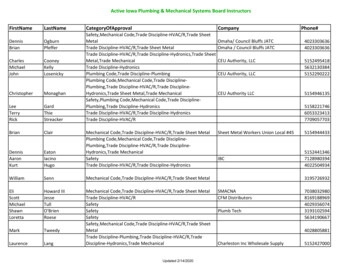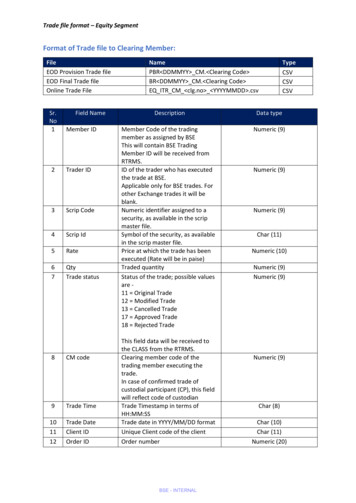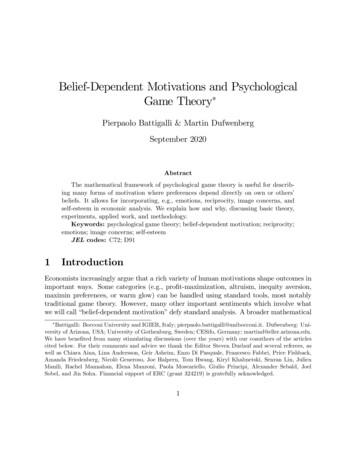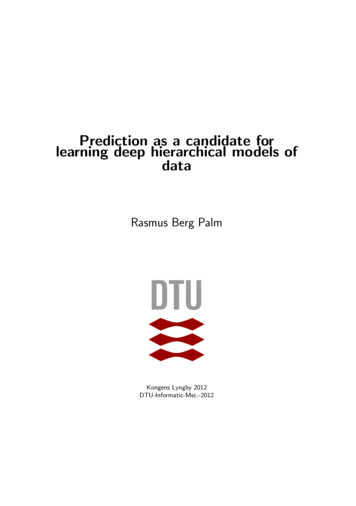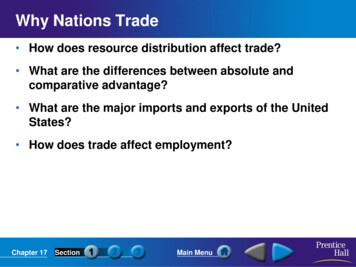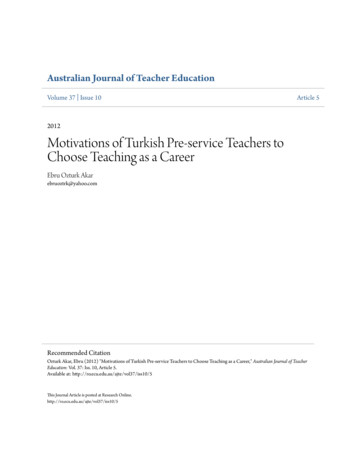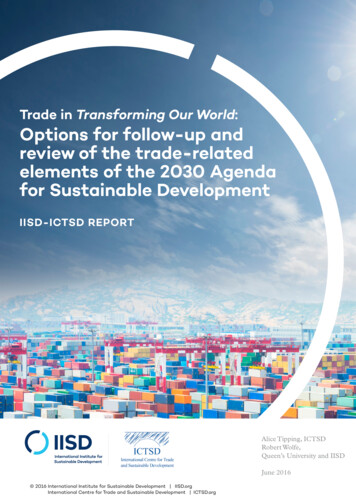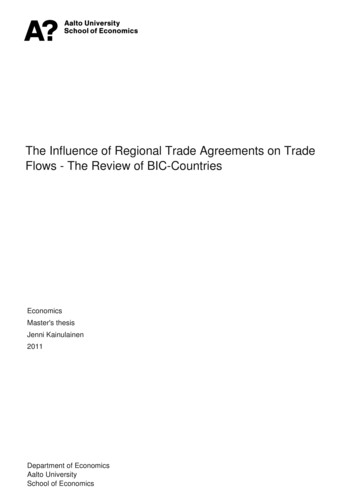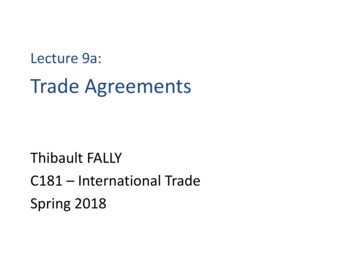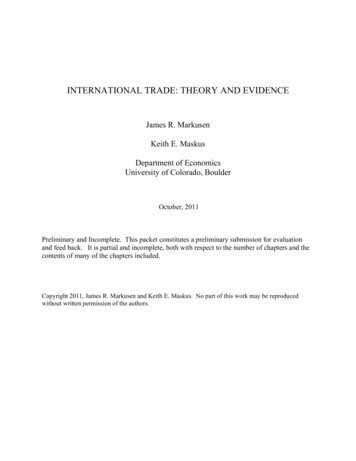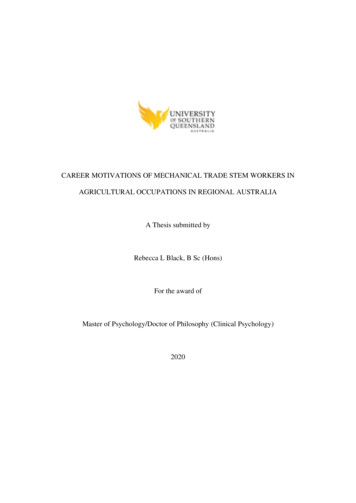
Transcription
CAREER MOTIVATIONS OF MECHANICAL TRADE STEM WORKERS INAGRICULTURAL OCCUPATIONS IN REGIONAL AUSTRALIAA Thesis submitted byRebecca L Black, B Sc (Hons)For the award ofMaster of Psychology/Doctor of Philosophy (Clinical Psychology)2020
iiABSTRACTThe development of Australia’s agricultural workforce is central to food and fibre security,and the national economy. Workers within middle skilled professions, such as mechanicaltrade workers educated via Vocational Education and Training (VET) pathways, areunderrepresented in career development research. This research aimed to understand thepsychological factors that influence career motivations of mechanical trade Science,Technology, Engineering and Mathematics (STEM) occupations in Australian agriculture.The research design was situated in an emergent paradigm, the Vocational Psychology ofAgriculture (VPA) and utilised the Social Cognitive Career Theory (SCCT) to formulateresearch questions and hypotheses. Integrative SCCT modelling of persistence enabledmapping of the relationships between seven predictor variables: (a) personality and affectivestates, (b) contextual barriers and supports, (c) self-efficacy, (d) sources of self-efficacy,(e) outcome expectations, (f) interests, and (g) goal-directed activity, and their direct andindirect influence on satisfaction and persistence intentions (Lent, Miller, et al., 2016). Amixed-method exploratory sequential research design was utilised across two studies. StudyOne involved semi-structured interviews with a sample of 19 mechanical trade STEMworkers, utilising thematic analysis to facilitate operationalisation of the core SCCTconstructs within the mechanical trade domain. Study Two involved cross-sectional onlinesurveys with a sample of 302 mechanical trade STEM workers, utilising multiple hierarchicalregression and path analysis to test an integrative SCCT model of mechanical tradepersistence. While the results were unable to support the role of self-efficacy in predictingsatisfaction and persistence intentions of mechanical trade workers, goal-directed work effortwas found to mediate the effect of ability-based outcome expectations on satisfaction.Satisfaction remained a key predictor of persistence intentions within the mechanical tradecontext.
iiiCERTIFICATION OF THESISThis Thesis is entirely the work of Rebecca Leigh Black except where otherwiseacknowledged. The work is original and has not previously been submitted for any otheraward, except where acknowledged.Principal Supervisor: Professor Peter McIlveenAssociate Supervisor: Dr Nancey HoareAssociate Supervisor: Dr Nicole McDonaldStudent and supervisors’ signatures of endorsement are held at USQ.
ivACKNOWLEDGEMENT STATEMENTI would like to express my sincerest appreciation to my principal supervisor,Professor Peter McIlveen. He has provided me tremendous opportunity to develop as aresearcher through the Australian Collaboratory for Career Employability and Learning forLiving (ACCELL) team. Peter’s unwavering support, incredible patience, and empatheticapproach have been the guiding light through this incredible journey. This thesis is a directresult his commitment to bringing vocational psychology into the field of agriculture. I willforever consider myself an ‘accelerant.’ Carpe Vinum.I am also extremely grateful to my associate supervisor Dr Nancey Hoare, who hasbeen there from the beginning of my Master’s program, guiding me into the world of careerresearch. Nancey is an incredible woman, who has acted as role model for me in every aspectof this professional journey. Lastly, but by no means least, I wish to thank my associatesupervisor Dr Nicole McDonald. Our team’s agvocate, she has truly immersed herself intothis research journey, through every question and thought I’ve had, becoming a true friendand trusted colleague along the way.The experience of completing a PhD offered opportunity far greater than I everimagined. The program has involved an incredible amount of work, the dedication to whichhas impacted every aspect of my life. It would not have been possible without years ofpractical and emotional support from my family and friends, and career guidance from mycolleague Associate Professor Gavin Beccaria.My husband and partner, Kris has been unwavering in his support of my career andentry into agriculture. Luckily, I believe that this experience has given my children theopportunity to develop resilience and see firsthand what true commitment takes. Our familycan’t wait to have our weekends back though, as we’re ready to get started on the next phaseof our journey together.
vFinally, I want to thank the University of Southern Queensland for supporting mefinancially through this educational journey. This research has been supported by anAustralian Government Research Training Program (RTP) Fees Offset and StipendScholarship, both of which I am honoured to have received and am grateful for. I lookforward to continuing my academic career at USQ, amongst a team of outstandingprofessionals.
viTABLE OF CONTENTSABSTRACT .iiCERTIFICATION OF THESIS . iiiACKNOWLEDGEMENT STATEMENT . ivTABLE OF CONTENTS . viLIST OF TABLES .xiiLIST OF FIGURES . xivLIST OF ABBREVIATIONS . xvLIST OF CONFERENCE PRESENTATIONS . xviCHAPTER ONE: INTRODUCTION . 1Australia’s Regional Workforce . 1Agricultural Careers . 3STEM Skills . 4Mechanical Tradespeople . 6Development of Career Paths . 6A Vocational Psychology of Agricultural Careers . 7An Integrative SCCT Model of Persistence. 10Aims and Research Questions . 12Anticipated Research Outcomes. 13Organisation of the Thesis . 14CHAPTER TWO: LITERATURE REVIEW . 16Australian Agriculture . 16Production Demands . 16Consumer Preferences . 17Technological Advancement . 18
viiEconomics . 18Urbanisation/Depopulation. 19Infrastructure . 20Workforce Priorities. 21Improving Productivity and Competitiveness . 21Embracing Change . 22Repositioning Perception. 23Social Cognitive Career Theory. 24Agriculture. 27Persistence . 28Theorising an Integrative SCCT Model of Mechanical Trade Persistence . 29Satisfaction . 30Contextual Barriers and Supports. 33Mechanical Trade Self-Efficacy . 35Sources of Realistic Self-Efficacy . 38Outcome Expectations . 40Personality and Affective States. 45Realistic Interests. 48Research Questions . 50CHAPTER THREE: METHODOLOGY . 52Philosophical Perspective: Postpositivism. 52Axiological Considerations of the Research Project . 53Vocational Psychology of Agriculture . 53Psychology of Working Framework . 54Researcher-as-Instrument Statement . 55
viiiMixed-Methods Approach . 58Conclusion . 61CHAPTER FOUR: STUDY ONE . 62Method . 64Participants . 64Participant Recruitment . 65Source of Data . 67Ethical Considerations . 70Trustworthiness and Rigour of the Research. 73Data Analysis. 74First Phase: Familiarisation with the Data. . 74Second Phase: Coding the Data. . 75Third Phase: Searching for Themes. . 75Fourth Phase: Reviewing Themes. 75Fifth Phase: Defining and Naming Themes. . 76Sixth Phase: Producing the Report. 76Results . 76Satisfaction . 78Job Satisfaction. . 78Occupational Satisfaction. . 79Contextual Barriers and Supports. 80Contextual Barriers. . 80Perceived Organisational Support. . 96Mechanical Trade Self-Efficacy . 104Sources of Realistic Self-Efficacy. . 106
ixOutcome Expectations . 123Variety. 123Compensation. 127Working Conditions . 130Security. . 132Ability Utilisation. . 134Achievement. . 135Coworkers. . 137Social Service. 140Supervision-Human. . 141Supervision – Technical. . 142Responsibility. 143Autonomy. 144Advancement. . 144Social Status. . 148Personality and Affective Traits . 149Diligence. . 149Prudence. . 150Consistency of Interest. . 152Persistence of Effort. . 153Realistic Interests. 155Discussion . 159Conclusion . 187CHAPTER FIVE: STUDY TWO . 191Model and Corresponding Hypotheses . 192
xMethod . 194Participants . 194Procedure . 195Ethical Considerations . 197Measures . 199Withdrawal Intentions. . 199Satisfaction. . 200Perceived Organisational Support. . 201Mechanical Trade Self-Efficacy. . 203Sources of Realistic Self-Efficacy. . 204Outcome Expectations. . 205Goal-Directed Activity. 207Plan for Data Analysis . 208Results . 210Data Screening. 210Mechanical Trade Self-Efficacy . 214Descriptive Statistics and Measure Correlations . 218Confirmatory Factor Analyses . 220Regression Analyses. 222Job Satisfaction. . 222Occupational Satisfaction. . 225Job Withdrawal Intentions. . 228Occupational Withdrawal Intentions. . 232Path Analyses . 236Mediation Analyses . 240
xiDiscussion . 242CHAPTER SIX: GENERAL DISCUSSION. 244Main Findings . 246Theoretical Implications . 247Persistence . 247Satisfaction . 248Contextual Barriers and Supports. 249Mechanical Trade Self-Efficacy . 250Sources of Realistic Self-Efficacy . 252Outcome Expectations . 253Personality and Affective States. 255Realistic Interests. 256Goal-Directed Activity . 257Practical Implications. 258Methodological Implications . 262Limitations . 263Future Research . 264Conclusion . 266References . 267Appendix A: Study One Interview Proforma . 286Appendix B: Study Two Survey Measure - The Australian Survey of Mechanical TradeCareers . 289
xiiLIST OF TABLESTable 1 Study One Interview Schedule . 68Table 2 A Summary of Mechanical Trade Occupational Domain Context Terms Adapted fora Measure of Mechanical Trade Self-Efficacy. 105Table 3 Face Validity of the Job Satisfaction Scale (JSS) . 161Table 4 Face Validity of the Occupational Satisfaction Scale (OSS) . 162Table 5 Face Validity of the adjusted Perceived Organisational Support (POS) Scale forPerceived Coworker Support, Perceived Organizational Support, and Perceived SupervisorSupport (adjusted POS-13 item) Scales . 163Table 6 Face Validity of Mechanical Trade Self-Efficacy Scale . 167Table 7 Face Validity of the Learning Experiences Questionnaire (LEQ) . 170Table 8 Face Validity of the Minnesota Importance Questionnaire (MIQ) . 174Table 9 Face Validity of the Work Effort Scale – 10 items (WESC-10). 182Table 10 Integrative SCCT Model of Mechanical Trade Persistence Theoretical ConstructThemes, Codes, and Operationalised Construct Measures . 188Table 11 Descriptive Statistics and Subscale Correlations for Mechanical Trade SelfEfficacy Scale . 216Table 12 Reported CFA Fit Statistics for Mechanical Trade Self-Efficacy Subscale . 217Table 13 Subscale Correlations, Descriptive Statistics, and Internal Consistency CoefficientCronbach α in Parentheses . 219Table 14 Reported Confirmatory Factor Analysis Fit Statistics for Subscales with SufficientParameters . 221Table 15 Multiple Regression Coefficients for Predicting Job Satisfaction . 224Table 16 Multiple Regression Coefficients for Predicting Occupational Satisfaction . 227Table 17 Multiple Regression Coefficients for Predicting Job Withdrawal Intentions . 230
xiiiTable 18 Multiple Regression Coefficients for Predicting Occupational WithdrawalIntentions. 234Table 19 Goodness of Fit Summary Table for an Integrative SCCT Model of MechanicalTrade Persistence. 237Table 20 Mediation Model of Ability on Occupational Satisfaction via Work Effort . 241
xivLIST OF FIGURESFigure 1 Social Cognitive Model of Agricultural Career Interest Development via OPEAFeedback Loop . 9Figure 2 An Integrative Model of Interests, Satisfaction, and Choice Stability . 11Figure 3 Integrative SCCT Model of Persistence Highlighting Direct Paths to and fromSatisfaction. 32Figure 4 Integrative SCCT Model of Persistence Highlighting Direct Paths to and fromContextual Barriers and Supports . 34Figure 5 Integrative SCCT Model of Persistence Highlighting Direct Paths to and from SelfEfficacy . 36Figure 6 Integrative SCCT Model of Persistence Highlighting Direct Paths to and fromOutcome Expectations . 41Figure 7 Integrative SCCT Model of Persistence Highlighting Direct Paths from Personalityand Affective States . 46Figure 8 Integrative SCCT Model of Persistence Highlighting Direct Paths to and fromInterests . 49Figure 9 Sequential Mixed-Methods Research Design for the Current Research Project . 59Figure 10 Theorised Integrative SCCT Model of Mechanical Trade Persistence . 77Figure 11 An Integrative SCCT Model of Mechanical Trade Persistence . 193Figure 12 Two Factor CFA Model of the Mechanical Trade Self Efficacy Scale IndicatingStandardised Path Coefficients for the Corresponding Items and Variance Explained . 217Figure 13 Trimmed Integrative SCCT Model of Mechanical Trade Persistence with PathCoefficients . 237Figure 14 Respecified Integrative SCCT Model of Mechanical Trade Persistence with PathCoefficients . 239
xvLIST OF ABBREVIATIONSSTEMscience, technology, engineering, and mathematicsVETVocational Education and TrainingVPAvocational psychology of agriculturePOWpsychology of workingSCCTsocial cognitive career theoryACCELLAustralian Collaboratory for Career, Employability, and Learning for LivingTAFETechnical and Further EducationRIASECrealistic, investigative, artistic, social, enterprising and conventionalUSQUniversity of Southern QueenslandJSSJob Satisfaction ScaleOSSOccupational Satisfaction ScalePOSPerceived Organisational SupportSPOSSurvey of Perceived Organisational SupportSPSSSurvey of Perceived Supervisor SupportSPCSSurvey of Perceived Coworker SupportLEQLearning Experiences QuestionnaireMIQMinnesota Importance QuestionnaireWESCWork Effort ScaleASGS-RAAustralian Statistical Geography StandardCFAconfirmatory factor analysisCFIcomparative fit indexTLITucker-Lewis indexRMSEAroot-mean square error of approximationMCARmissing completely at randomMARmissing at randomMNARmissing not at random
xviLIST OF CONFERENCE PRESENTATIONSBlack, R. (2019, May 22). Career motivations of mechanical trade STEM workers inagricultural occupations in regional Australia [Poster presentation]. Asia PacificCareer Development Association Conference, RMIT University, Ho Chi Minh City,Vietnam.Black, R. (2019, Octob
SPOS Survey of Perceived Organisational Support SPSS Survey of Perceived Supervisor Support SPCS Survey of Perceived Coworker Support LEQ Learning Experiences Questionnaire MIQ Minnesota Importance Questionnaire WESC Work Effort Scale ASGS-RA Australian Statistical Geography Standard CFA confirmatory factor analysis CFI comparative fit index
